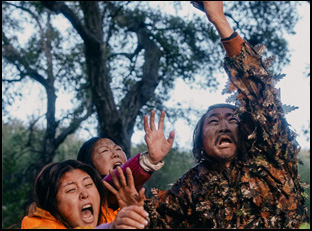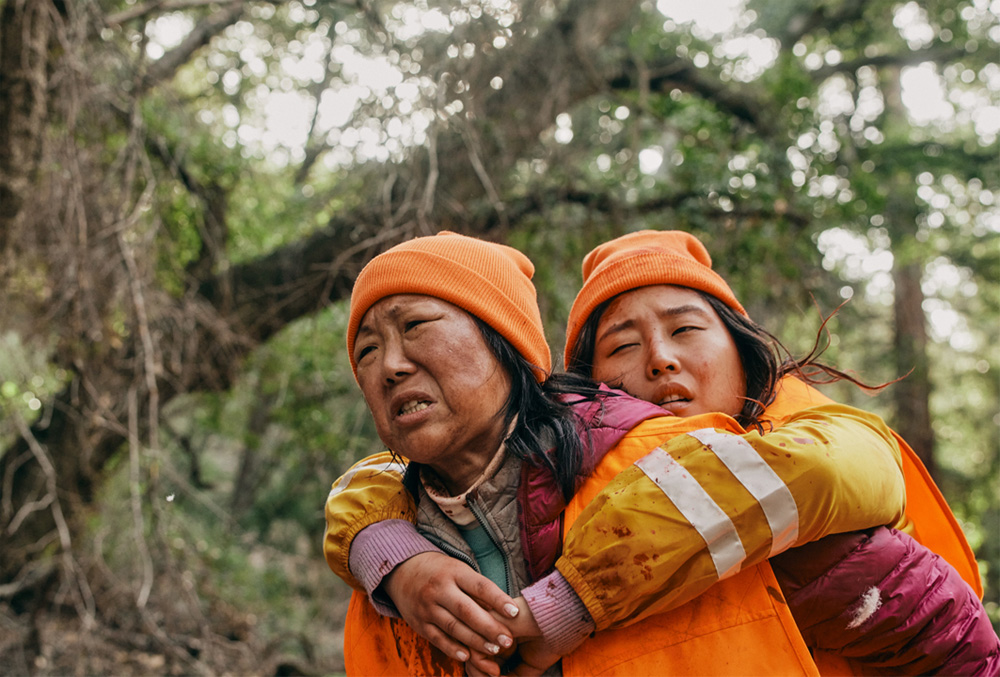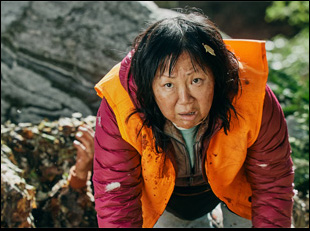The bad ideas begin in “A Family Guide to Hunting” when Eva (Kahyun Kim) thinks nothing of inviting her parents (Margaret Cho and Keong Sim) along for a hunting trip with her boyfriend Peter (Craig Newman), thinking it might be a good way to bond. After all, her mother “doesn’t like anyone, including my dad,” she insists to her beau and Peter is uniquely equipped to deal with the situation as he’s readied himself to survive just about anything as a doomsday prepper. Still, when everyone comes to the day with guns blazing, it feels like a disaster is inevitable.
Yet Zao Wang’s dark comedy short ultimately proves to be disarming when in spite of certain assumptions proven right almost immediately, which the director gets ahead of when first introducing Eva caked in blood before flashing back, the biggest surprise of many in “A Family Guide to Hunting” may be that it’s an insightful look at tortured family dynamics at heart when tragedy strikes and Eva’s strained relationship with her parents is brought into focus as they attempt to rectify one horrific situation and in doing so, it may seem like mending fences with each other may be even more insurmountable. Set in the middle of the woods, no one seems as if they can see the forest for the trees when working together to find a solution to an emergency would require trust that was apparently broken when Eva first started dating Peter, and while there’s nothing in his extremist attitude that would make it look like her parents’ first impression was a wrong one, the fact that they’ve been a bit overprotective and unable to let her make her own mistakes looks to be at least partially responsible for the predicament they’re in.
Beyond showing a wicked sense of humor, Wang, with co-writers Tom Toro and Carmel Banasky, cleverly create a scenario that brings so much up to the surface about the strained relationships at hand as well as the weird ways the family ends up expressing their love to one another when no one would dare say it directly. With a sharp cast led by Cho that is able to rise to the dramatic demands of the roles as much as the comedy, the film is a real treat and is poised to charm audiences at Tribeca this week where it is making its world premiere. On the eve of delivering a jolt to New Yorkers, Wang and producers Joyce Liu-Countryman and Louise Barretto spoke about how as difficult as things might look for the family on screen, it may have been even harder to film in a location without electricity or an easy pathway for equipment to make it to set, making this a tale of perseverance both behind and in front of the camera.
Zao Wang: This is kind of autobiographical…no, I’m kidding. It didn’t happen for real, but the inspiration was really just wanting to talk about an Asian American family and love and how that could be seen on the screen in a way that we haven’t seen before, so a lot of this was inspired by how I thought my parents would react in this situation. Immediately, I thought that was funny and dark.
Joyce Liu-Countryman: When Zao sent me the script, I was like, “This is sooo dark, I’m in.” [laughs]
Louise Barretto: Joyce and I were working on Film Independent Project Involve and she’s my mentor [in that program], and she’s like, “Do you want to be on board for this? Let’s meet Zao and we got on this crazy ride together.”
Zao, I don’t want to give anything away, but how did you crack the actual story for this to show the family dynamics at play?
Zao Wang: It was definitely a process. This actually started out as a feature film that my partner and I wrote during the pandemic, but we wanted to make something really fast, so we took a portion out of the feature film and tried to make a short. But in trying to do that, you have to still convey all the character relationships and the soul of the story, so that actually took a while to condense into a standalone short. Then we had another writer come on board to really punch up all these character relationships within a matter of a few pages. So it was definitely a work in progress and even throughout the whole casting and auditioning process we were revising the script to shape the story in a way that can get the most out of a couple of minutes.
It seems like Margaret Cho would bring some instant energy to this.
Zao Wang: I always thought that she would be the perfect mom for this story. I had seen her on TV in the ’90s when I first came to this country. She was doing stand-up, and I didn’t understand what she was saying, but I knew she was important, and I was fascinated by her. Fast forward to imagining who could play the mom in this story and immediately, she came to mind. In fact, I don’t think I would know how to make this film without her. But then I [thought] how do we actually get her? That was the challenge. And then enter Joyce and Louise.
Joyce Liu-Countryman: Okay, I’m going to name drop. That’s what I do. [laughs] Ken Jeong and I are working on a project together and Ken is really good friends with Margaret and because this part was really written for Margaret, I said to Ken, “Can you hook me up? And he told me, “Send her reps an e-mail and drop my name because it’s Hollywood. That’s how we do it.” Then Zao wrote this really beautiful, heartfelt letter to her that went with the package, and you know Margaret — she’s into dark comedy, so she read it and it was in a way very easy in that it was just so well-written and so poignant, it hit her touchstones. We met with her after a show so that she could make sure we weren’t nuts and we loved her as an actor, but we really wanted to sweeten the deal, so we invited her to be an executive producer and then she’s like, “I’m in.”
What was it like to get the rest of this great cast for the family?
Joyce Liu-Countryman: Well, we went through the casting process with auditions and reaching out to folks. Keong [Sim, who plays the father Sam] submitted his self tape. Kahyun [Kim, who plays Eva, the daughter] was through our casting director, Brian Sounalath, who said, “Have you heard of Kahyun?” And she submitted this incredible self-tape. It blew us away.
Zao Wang: Yeah, I still have it saved on my computer.
Louise Barretto: And this was before she was coming out with “Cocaine Bear.” So she was just about to blow up and we thought, “Oh my God, she’s funny in ‘Cocaine Bear.'” So we were like, “Oh my gosh, yes, this is great.”
Joyce Liu-Countryman: It was like when you find someone who’s incredibly talented and you’re just waiting, [wondering when] they’re going to break because you know they’re going to be huge. And we were just lucky enough to be in their presence now before they’re massive. That’s Kahyun.
Zao Wang: And once we cast the whole family, we put [their pictures] on the wall and we [thought], “They look perfect, right? But could they actually be a family on screen in real time?” So I had many one-on-one conversations with all of them, but then we brought them all together for a rehearsal. And it was a short film, so there was very little time, but we did bring them all together and we were all excited to be there. And during the rehearsal time, we improv-ed a couple of scenes because one of the ways I love to get the actors relaxed and trust each other is to come up with a scene that’s actually not in the film, but it’s like a backstory or a side story, so they just playing with each other. And Margaret is such a legend, we were intimidated [initially, wondering] how open is she going to be? But she was so generous and so giving immediately that she helped set the tone to make this family look real. That improv was hilarious, it was real, and we all just felt like, “Great, we have a family.”
Joyce Liu-Countryman: And Kahyun was in South Korea, so my job was to hold up the laptop on Zoom while they were rehearsing [on the other side of the world] so they can rehearse with her.
 A producer always has to do everything. And I wondered what was it like to find the forest as a backdrop?
A producer always has to do everything. And I wondered what was it like to find the forest as a backdrop?
Joyce Liu-Countryman: We’d scouted a number of different locations around Los Angeles because to find this wilderness in this urban center of Los Angeles [is a challenge], but we were really lucky because we had an associate producer on this project who did a fabulous job of finding this location for us, which ended up being the biggest beast to overcome for our show because there was no electricity, no wi-fi, no cell service and no running water. We couldn’t have motorized vehicles [to get to it], so we had to carry everything in, but it looks amazing, right?
Louise Barretto: Don’t forget the bridge we had to build a bridge to cross over the creek.
Zao Wang: We hand-built two bridges because there’s a creek right there and we had to cross the creek to get to where we were shooting.
Louise Barretto: And it was about a mile away from base camp. And there was no electricity at base camp, then we’d walk one mile to get to set. It was rough every time.
Joyce Liu: And the bridges were like 150 pounds.
Louise Barretto: Four people had to carry it every day, night and day.
Zao Wang: We had to carry everything in and out because it was a national park and we had to abide by all the park rules.
Was the production made any more difficult by the fact that the film plays out in two distinct halves – before and after a certain event – and the second half your cast is caked in blood?
Zao Wang: Absolutely because the film location was on one side of the creek and makeup and wardrobe [were] on the other a mile away at base camp, so we really had to schedule this in a way that that would save the most amount of time during the day, We were shooting outdoors in the winter in a bit of a valley, so daylight was very limited and we practically shot everything chronologically [which] was important, not just from a production standpoint, but also [in terms of] the characters emotional journey throughout the whole thing.
You’re able to also get a number of different angles on every shot, which must’ve been pretty difficult in this particular location where there could’ve been so many obstructions with trees and rocks. What was it like to figure out?
Zao Wang: Yeah, it was definitely a challenge setting the camera up anywhere in that terrain. Even on sticks and on tripods, it was difficult to level things, let alone with certain movement. We had some moving shots on a small Dana Dolly, but it all really comes down to preparation. We scouted the location several times and I went back there myself a few times just to let the location sink in, to live in that space and imagine where your eyes would be and knowing the challenge of the production, what would be the best way to shoot this? Other than the traditional coverage, I didn’t want this to feel like a traditionally covered film. The shots still need to be interesting and tell a story.
Once you’re on set, you’re dealing with all kinds of stuff, so preparation was key. But there was definitely one scene that would have been impossible to plan out every shot without seeing how the actors would play it. I had some basic ideas of how the scene could go, so on that day we basically spent the whole day on that scene and I blocked every person from the location there and came up with the shots there and then, knowing that I had to get it in a few [different] pieces. But other than that, I wanted to let the actors dictate the movement and the shots.
Joyce Liu: This is also a testament to the partnership between Zao and our [director of photography] Brian Nguyen, because Brian [said] “This is the most prep I’ve ever done for any film, including a feature.” [laughs] And I think that shows in the film, just the amount of time they put in to really think through what was possible and what they need to do.
It’s quite accomplished. What’s it like to get to Tribeca with this?
Louise Barretto: Oh my gosh. All I want to do is party. We’ve worked so hard — Joyce, Zao and I — [we’ve been] relentless in trying to get this to be made and even just trying to finish this for Tribeca and the premiere, so I’m ready to celebrate and meet all the filmmakers here.
Zao Wang: It’s just so amazing to be back in Tribeca with the film. This is really from the heart, and it’s a labor of love. and to actually have Tribeca recognize the film as something important to show and to share with the world means so much. Even more than that, I have a great team of collaborators — my producers, my writers, and everyone on the team — and we put in so much work into this film, so it’s really wonderful to bring everyone to the festival and to celebrate together. Of course, this is only the beginning of the journey. We have a feature to come.
“A Family Guide to Hunting” will screen at the Tribeca Festival at the AMC 19th St. East 6 on June 14th at 8:30 pm, June 15th at 8:45 pm and June 16th at 8:30 pm.





